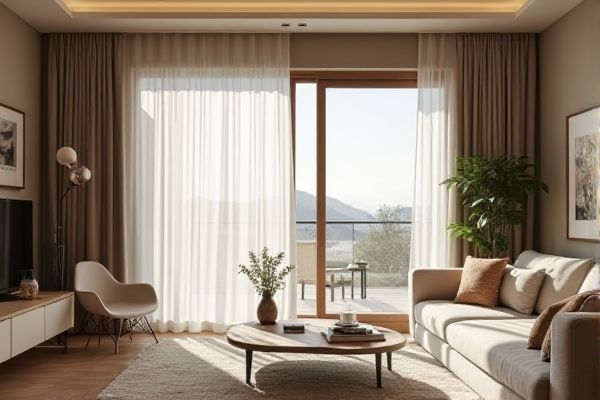
Privacy curtains offer a soft, fabric-based barrier that enhances indoor aesthetics while providing effective light control and privacy. Outdoor blinds deliver durable, weather-resistant protection that shields your space from sun, wind, and rain; explore this article to discover which option best suits your needs.
Table of Comparison
| Feature | Privacy Curtains | Outdoor Blinds |
|---|---|---|
| Primary Use | Indoor privacy and light control | Outdoor privacy, shade, and weather protection |
| Material | Fabric (polyester, cotton, blends) | Weather-resistant materials (PVC, mesh, vinyl) |
| Installation | Mounted on curtain rods or tracks indoors | Mounted on exterior walls, patios, or pergolas |
| Privacy Level | High indoor privacy; blocks view through windows | High outdoor privacy; blocks view and UV rays |
| Light Control | Adjustable; filters or blocks natural light | Adjustable; controls sunlight and glare outdoors |
| Weather Resistance | Not weather-resistant; indoor use only | Designed for outdoor exposure; water and UV resistant |
| Durability | Moderate; depends on fabric quality | High; built to withstand outdoor elements |
| Maintenance | Machine washable or dry clean | Wipe clean; occasional deep cleaning needed |
| Cost | Generally lower cost | Typically higher cost due to materials and installation |
Introduction to Privacy Curtains and Outdoor Blinds
Privacy curtains offer a soft, fabric-based solution that enhances indoor privacy and controls natural light, making them ideal for bedrooms and living areas. Outdoor blinds, crafted from durable materials like PVC or mesh, provide weather-resistant shading and privacy for patios and balconies while allowing airflow. Understanding the distinct advantages of each helps you choose the right option for your specific space and privacy needs.
Key Differences Between Privacy Curtains and Outdoor Blinds
Privacy curtains provide a fabric barrier primarily designed for indoor use to block visibility and enhance privacy, while outdoor blinds are weather-resistant panels that shield outdoor spaces from sun, wind, and rain. Privacy curtains typically offer limited protection against elements, whereas outdoor blinds are constructed with durable materials like PVC or aluminum to withstand harsh outdoor conditions. Privacy curtains prioritize aesthetic appeal and interior privacy, whereas outdoor blinds focus on functionality and environmental protection.
Material Comparison: Durability and Maintenance
Privacy curtains typically use fabric materials like polyester or cotton blends that offer softness and easy maintenance but may wear out faster in high-traffic or humid areas. Outdoor blinds are often made from durable materials such as PVC, vinyl, or aluminum, providing superior weather resistance and requiring minimal upkeep compared to fabric alternatives. Choosing outdoor blinds enhances your space's longevity and reduces maintenance efforts, especially in exposure-prone environments.
Design and Aesthetic Appeal
Privacy curtains offer a soft, fabric texture that enhances indoor warmth and coziness, making them ideal for creating intimate spaces with customizable patterns and colors. Outdoor blinds provide a sleek, modern look with durable materials like aluminum or PVC, designed to withstand weather conditions while complementing contemporary architectural styles. Both options enhance aesthetic appeal by aligning with specific design goals: curtains emphasize comfort and softness, whereas blinds prioritize minimalism and functionality.
Installation Processes and Requirements
Privacy curtains typically require a simple installation process, involving mounting a curtain rod or track system inside your home, which demands minimal tools and wall anchors. Outdoor blinds, however, often necessitate more robust fixtures and precise measurements to withstand weather conditions, usually needing professional installation to ensure durability and proper sealing. Understanding these differences helps you choose the best option based on your home's structure and your willingness to manage installation complexity.
Weather Resistance and Longevity
Privacy curtains typically offer moderate weather resistance but may degrade faster when exposed to prolonged sunlight, moisture, or wind due to fabric materials prone to fading and mildew. Outdoor blinds are designed with durable materials such as PVC, aluminum, or treated wood, providing superior weather resistance against UV rays, rain, and temperature fluctuations, which enhances their longevity. Investing in outdoor blinds generally ensures a longer-lasting solution for protection against varying weather conditions compared to privacy curtains.
Light Control and Privacy Levels
Privacy curtains provide excellent light control by blocking out sunlight completely, ensuring maximum privacy for indoor spaces. Outdoor blinds offer adjustable light filtering options, allowing you to manage sunlight while maintaining some visibility and airflow. Your choice depends on whether you prioritize total privacy and darkness or flexible light management with partial privacy outdoors.
Cost Analysis: Budget Considerations
Privacy curtains typically cost less upfront, with prices ranging from $20 to $60 per panel, making them a budget-friendly option for indoor use. Outdoor blinds, however, tend to be more expensive, averaging between $150 and $400 per unit due to durable, weather-resistant materials and installation requirements. When considering long-term value, outdoor blinds often offer better protection and durability, potentially reducing replacement frequency and maintenance costs over time.
Best Uses for Privacy Curtains vs Outdoor Blinds
Privacy curtains are ideal for creating intimate, flexible indoor spaces such as bedrooms, living rooms, or offices where soft, sound-dampening barriers are needed. Outdoor blinds excel in protecting patios, decks, and verandas from harsh weather elements while providing adjustable light control and maintaining outdoor visibility. Both options enhance privacy, but curtains prioritize indoor comfort and aesthetics, whereas outdoor blinds emphasize durability and environmental protection.
Conclusion: Choosing the Right Option for Your Space
Privacy curtains provide a soft, flexible barrier ideal for creating intimate indoor spaces, while outdoor blinds offer durable protection against weather and enhance exterior privacy. Your choice depends on the specific needs of your space, such as whether you require weather resistance or interior ambiance control. Assessing factors like sunlight exposure, privacy levels, and aesthetic preferences will help determine which option best suits your environment.
 homyna.com
homyna.com